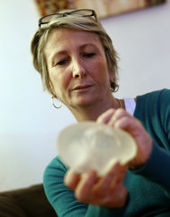
© GreenMedInfo
For most of the twentieth century mastectomy was the first line treatment for Ductal Carcinoma In Situ (DCIS), and younger patients were more likely to undergo the procedure. Even after lumpectomy and radiotherapy were shown to be at least as effective for invasive cancer as mastectomy, still in 2002, 26% of DCIS patients were still receiving mastectomy.
1The most common scenario today following diagnosis of DCIS is for the oncologist to recommend lumpectomy, followed by radiation and hormone suppressive therapies such as Arimidex and Tamoxifen. The problem here is that women are not being educated about the nature of DCIS or the concept of "non-progressive" breast cancers. There is still the black and white perception out there that you either have cancer, or do not have cancer. In a poll on DCIS awareness published in 2000, 94% of women studied doubted even the possibility of non-progressive breast cancers.
2 In other words, these women had no understanding of the nature of DCIS. And why would they? Major authorities frame DCIS as "pre-cancerous," implying its inevitable transformation into cancer. When the standard of care for DCIS is to suggest the same types of treatment used to treat invasive cancer, very few women are provided with the information needed to make an informed decision.
Early detection through
x-ray mammography has been the clarion call of Breast Cancer Awareness campaigns for a quarter of a century now. However, very little progress has been made in making the public aware about the crucial differences between non-malignant lesions/tumors and invasive or non-invasive cancers detected through this technology. When all forms of breast pathology are looked at in the aggregate, irrespective of their relative risk for harm, disease of the breast takes on the appearance of a monolithic entity that you either have, or don't have; they call it breast cancer.
The concept of a breast cancer that has no symptoms, which can not be diagnosed through manual palpation of the breast and does not become invasive in the vast majority of cases, might sound unbelievable to most women. However, there does exist a rather mysterious clinical anomaly known as Ductal Carcinoma In Situ (DCIS), which is, in fact, one of the most commonly diagnosed and unnecessarily treated forms of "breast cancer" today.
What women fail to understand - because their physicians do not know better or have not taken care to explain to them - is that they have a choice when diagnosed with DCIS. Rather than succumb to aggressive treatment with surgery, radiation and chemo-drugs, women can choose watchful waiting. Better yet, a radical lifestyle change can be focused on eliminating exposure to chemicals and radiation, as well as improved exercise and nutrition. This choice is not being made in most cases because the medical community is not informing their patients that there is such.

Comment: The following articles were written by author and researcher Jeffery Smith; director of the Institute for Responsible Technology:
The GMO Tipping Point
GMO Researchers Attacked, Evidence Denied, and a Population at Risk
Genetically Modified Soy Linked to Sterility, Infant Mortality in Hamsters
GMOs Linked to Organ Disruption in 19 Studies
Monsanto's Roundup Triggers Over 40 Plant Diseases and Endangers Human and Animal Health
Non GMO Month: An Interview with Jeffery Smith